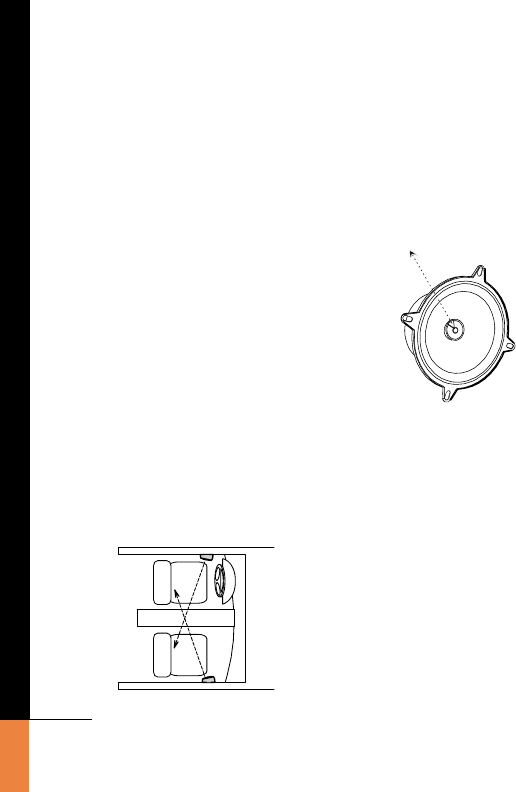
04
Speaker Placement
Because of the Power Series speakers’
versatile mounting options, there are
many placement options that will achieve
excellent sound quality in your vehicle.
Please consider the following to help you
get the most from your speakers.
1. The most spacious stereo image is
achieved when the left and right speakers
are placed as far apart as possible.
2. The best center image will be achieved
when the distance from the left speaker
and the right speaker are as equal as pos-
sible from your listening position. This is
most easily achieved by placing the
speakers as far forward as possible.
3. Treble is directional in nature. This
means that high frequencies are reduced
as you move off the tweeter’s axis. If pos-
sible, rotate the speakers so that the angle
of the tweeter points across the car to the
listener on the opposite side. This will
make each listener slightly off-axis to the
tweeter that is closest to that listener, but
on axis to the most distant speaker, which
helps compensate for the fact that each
listener is always closer to one speaker
than to the other (see Figures 4a and 4b).
Choosing mounting locations that satisfy
all of the above criteria will provide the
most satisfying performance.
Figure 4a
Figure 4b
System Design
A more advanced system design can be
achieved by adding a Decade,™ GT,
Power, GTi, or equivalent subwoofer to
your Power Series speakers. In this case
the Power Series multi-element speakers
will be used as high and midbass fre-
quency drivers and should have their
extremely low frequencies blocked by
electrical means. Active or passive
crossovers can be used in order to
achieve the best system fidelity and
widest dynamic range. A crossover fre-
quency of between 80Hz and 120Hz is
recommended for the best imaging and
widest dynamic range.
Installation Warnings
and Tips
• Be careful not to cut or drill into fuel
tanks, fuel lines, brake or hydraulic lines,
vacuum lines or electrical wiring when
working on your vehicle. Inspect behind
panels before you cut or drill.
• Make sure that the speaker will
physically fit in the mounting location. If
door mounting, check for adequate clear-
ance with the window in both closed and
open positions as well as for interference
with the window crank and power
window mechanism. If mounting else-
where, check for clearance around rear
deck torsion bars, glove box or other
structural elements.
• Do not mount speakers where they will
get wet.
• Make sure that it will be easy to run
connecting wires to the speakers. Trace
speaker wire paths before you undertake
mounting.
• Always disconnect the ground wire from
the battery before doing any work on the
vehicle.
CAUTION: Fuel tanks are located directly
beneath the rear deck in some cars. Check
for adequate speaker basket clearance
before considering this location!
A Note on Power Handling
As a result of their high efficiency, all JBL
loudspeakers will produce reasonable
volume levels in the automotive environ-
ment using very little amplifier power.
However, the use of a small amplifier to
attain very high volume levels could lead
to overdriving the amplifier. This will
generate high distortion levels which can
easily damage loudspeakers, even if the
rated power of the amplifier is below the
rated maximum power handling of the
loudspeaker!
As a general rule, do not turn up the
volume control past the point where
you hear distortion in the form of either
signal distortion from an overdriven
amplifier or mechanical noise from an
overstressed speaker.
For the best performance and speaker
reliability, you should select an amplifier
with an output rating slightly higher than
the maximum power likely to be used to
generate the desired volume levels. This
margin of reserve power will ensure that
the amplifier will not attempt to deliver
more power than its design allows.
WARNING: Playing loud music over
120dB can permanently damage your
hearing. The maximum volume levels
achievable with JBL speakers combined
with high power amplification may
exceed safe levels for extended listening.
When listening at high volume levels,
always use hearing protection or turn the
volume down!
Aim Triangle of Tweeter Diffuser
Toward Listener








